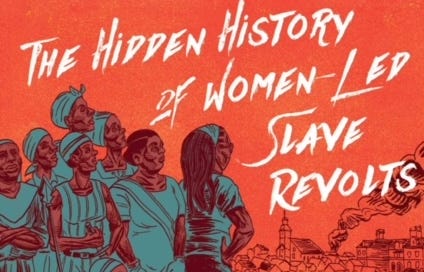Women-Led Slave Revolts In Graphic Detail
By Guest Contributor Kris Wood
My experience with graphic novels is twofold: One, my son reads manga on occasion. I read them first or alongside him. And two, my all-time favorite book series, Outlander, came out with one 15 years after I discovered the series.
Despite the artfully composed images of this series, it felt like a cartoon version of my beloved characters/storylines. The graphic novel made everything feel flat, linear, and two-dimensional. More so because the drawings did not depict the characters as I had envisioned them.
Wake, The Hidden History of Women-Led Slave Revolts by Dr. Rebecca Hall changed my entire perspective on graphic novels. Part memoir, Wake tells the story of women-led slave revolts through Hall's efforts to unearth the truth about these iconic women warriors whose story, until now, had been pushed to the margins.
For me, the illustrations by aspiring comic book artist Hugo Martinez brought the narrative to life and drew me into the journey. Additionally, the author inserted herself into the storyline which gave the discoveries of these women-led revolts more visual and emotional engagement and impact.
Following the footsteps of these women who history deemed unimportant prevented Ms. Hall from being able to recount an epic saga of any particular woman or family due to a lack of documentation. Consequently, the information available and shared is fragmented and brief, albeit powerful and enlightening.
The graphic novel format was a profound way to share this piece of history. Of the many paths Dr. Hall pursues in her research, she perseveres in finding historical documentation that “there were women warriors involved in wars, women from many different nations and ethnic groups fighting to protect their villages from slave traders” throughout West Africa.
By way of example, Dr. Hall showed diagrams of how the slave traders stowed the African captives…as “things to be stored, shipped and sold”. She shows how the lower deck of a ship held the human cargo, 292 slaves, packed elbow-to-elbow, feet-to-head to maximize space.
In the chapter entitled “Insurrection of Cargo”, when referencing how many captives died in transit from either jumping or being thrown overboard, Dr. Hall quotes this chilling excerpt:
“Sound waves travel so slowly underwater and the ocean is so vast, sounds can last centuries underwater. Maybe, if we listen carefully, we can hear them.”
Through her extensive research at Liverpool’s Maritime Archives, Dr. Hall uncovered travel logs that indicate that there was at least 1 revolt at sea per every 10 voyages and that the more women on board a slave ship, the greater likelihood for a revolt.
Why? How was this possible? Per the report of the Lords of the Privy Council, 1789: The slave, if a man, is put in irons on the main deck; if a boy, he is put on the main deck loose; if a woman or girl, they are placed without irons on the quarter deck. The women, therefore, took advantage of their ability to move somewhat freely about the ship to access weapons, planning and initiating one revolt after another.
In the end captives, women and men alike chose to fight and die rather than survive the horrors of slavery. Demoralizing and heart-wrenching, Wake shows us the toll that gathering this data had on Dr. Hall and the absolute necessity of taking a break to reconnect with the good in the world, to regain balance and purpose. Looking at more “mainstream” historical recounts of our country’s treatment and perception of these captives furthered the emotional turmoil, such as this excerpt from Thomas Jefferson’s Notes on the State of VA, dated 1785…
“A black, after hard labor through the day, will be induced by the slightest amusements to sit up till midnight, or later, though knowing he must be out with the first dawn of the morning. They are at least as brave and more adventuresome, but this may perhaps proceed from a want of forethought, which prevents their seeing a danger till it be present. Their griefs are transient…in general, their existence appears to participate more of sensation than reflection.”
Could it be these “blacks” he refers to were fostering a sense of community and compassion amongst one another at any opportunity regardless if it made them less productive to their white masters/enslavers? Truly, who would choose to go to bed early every night to ensure a good night’s rest so you can be abused, tortured, and worked to death the following day? Wouldn’t any one of us choose to join together, even at midnight, to share stories, grief, love, and support in order to survive another day?!
The audacity of those in power, then and now, is appalling. What’s disconcerting when reading accounts like this is that this isn’t ancient history, something that happened hundreds and hundreds of years ago. Slavery was still present in the US two centuries ago…TWO!
That’s just a couple of generations; it’s that close to our present. Recent enough that maybe if we listen hard enough, the screams and cries from those souls who died at sea can still be heard. We can then pay them homage by addressing and changing the narrative…it’s the least we can do.




